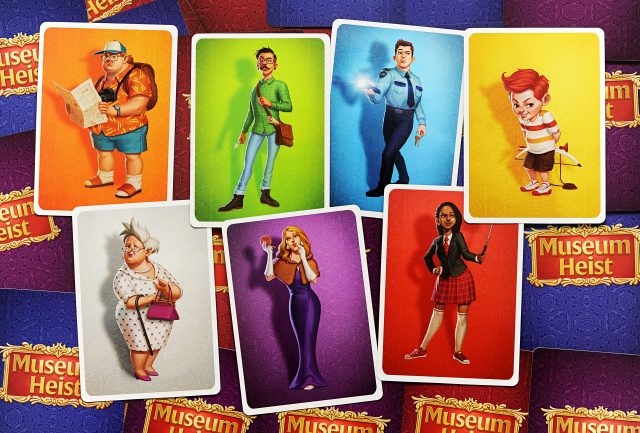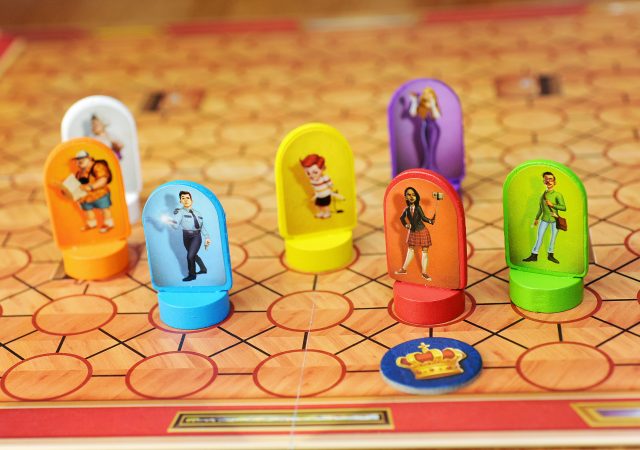I love a good caper movie. I could kill an afternoon watching flicks like The Sting, Oceans 11, The Thomas Crown Affair, or Sneakers. Maybe it’s the idea that the characters know just a little bit more than the audience, which is going to make the seemingly impossible to pull off, suddenly possible.
In Alex Randolph’s Museum Heist, you’re tasked with pulling off a robbery of a priceless work of art, actually three of them. Seven different thieves have been attracted by a new exposition showing of some beautiful pieces. There’s the student, the tourist, the guard, the granny, the little boy, and the artist. They are placed on the grid-like board of the museum floor, and an object d’arte is randomly placed on one of the free spaces of the museum. However, only you know which of the international art thieves represents you in the gallery. The first player to successfully steal three pieces wins the game and if recognized as the best thief around.
 Everyone secretly selects one of the seven thieves from their hand of cards. Each player has the same set of seven thieves, so it’s possible for several, or even all of the players to pick the same hood to do their bidding in the round. Of course, ideally you want to be the first person to reach the piece, but often a direct path is a very bad idea.
Everyone secretly selects one of the seven thieves from their hand of cards. Each player has the same set of seven thieves, so it’s possible for several, or even all of the players to pick the same hood to do their bidding in the round. Of course, ideally you want to be the first person to reach the piece, but often a direct path is a very bad idea.
On a turn, you can move one of the different thieves in the museum. They must always move towards the art piece, no matter where they are. Now, you can move any of the characters, not just the one you’ve chosen for the round. Here’s where some of the gamesmanship comes into play. If you’re too obvious with your movements, players can spend a turn to accuse you, and make a guess as to which character you are. If they’re right, they immediately win the art for that round. An incorrect guess means the accuser is out of the round. If this results in only one player left, they win the round and claim the art token, ending the round.
The round also ends when one of the characters lands on the art. If the active player has chosen the character that lands on the art in the round, they win the piece…that is, unless just one other player has chosen the character as well. In that case the other player gets the piece…that is, unless more than one player has picked that character. Then the active player wins the piece.
This dynamic of wanting to be the first to the piece, but not wanting to be discovered, makes for an interesting game of cat-and-mouse.
 You get two Swap tokens for the entire game. They allow you to spend a turn swapping two characters on the board, but once they’re spent, they’re gone, so you have to use them wisely.
You get two Swap tokens for the entire game. They allow you to spend a turn swapping two characters on the board, but once they’re spent, they’re gone, so you have to use them wisely.
Once a player acquires their third piece of art the game is over, and they’re recognized as the most talented of the of all the art thieves!
On my first play of Museum Heist, I enjoyed it, but didn’t see the depth of abstract and bluffing decisions you have to make throughout the game. Subsequent plays have revealed how many different ways there are to approach each round. Paying attention to the play style of the others at the table is key. Being able to win a round by correctly identifying someone, is extremely satisfying, but sometimes it’s worth it to take the risk and just go for the art itself.
Although being not much more than an overhead grid, the board is both pretty to look at and functional. A simple look is all it takes to see what your available options are. Four trap doors (cause what’s a museum without secret passages?) allow for fast passage around the gallery. The different characters are fun, and nicely represented on colourful wooden pawns.
 If the name Alex Randolph doesn’t immediately ring a bell, it may be because his heyday was the 80’s and 90’s. Randolph made a name for himself with titles like Code 777, Twixt, Ricochet Robots, and his Spiel des Jahres winning Enchanted Forest. He was incredibly influential at a time when Euro-style games were making an impact, and his distinct style still reverberates through the hobby today. Randolph and his games were even the inspiration for the Randolph Pub board game cafes in Montreal, Canada.
If the name Alex Randolph doesn’t immediately ring a bell, it may be because his heyday was the 80’s and 90’s. Randolph made a name for himself with titles like Code 777, Twixt, Ricochet Robots, and his Spiel des Jahres winning Enchanted Forest. He was incredibly influential at a time when Euro-style games were making an impact, and his distinct style still reverberates through the hobby today. Randolph and his games were even the inspiration for the Randolph Pub board game cafes in Montreal, Canada.
Museum Heist has a bit of a throw-back feel to the games you (or at least I) played growing up. The rules are easy to grasp, but there is a depth of strategy that will keep you coming back. You don’t always get to play a new game from classic designer, but when you do, it’s nice to see they still have chops to produce something great!
This sounds like it has more than a little of the ‘Cats’ mansion’ about it.